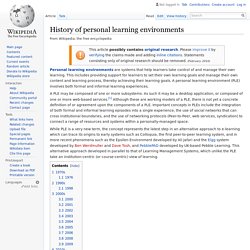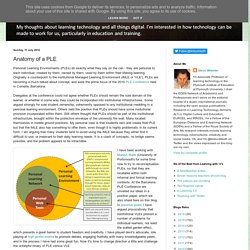

How To Create a Personal Learning Environment to Stay Relevant in 2013. “Our understanding of learning has expanded at a rate that has far outpaced our conceptions of teaching. A growing appreciation for the porous boundaries between the classroom and life experience…has created not only promising changes but also disruptive moments in teaching.” EDUCAUSE Review, 2012 This quote from Disrupting Ourselves: The Problem of Learning in Higher Education (Bass, 2012), gives a good a reason as any for educators to develop a Personal learning Environment [PLE]; a space where we can keep up with the experimental modes of learning, instruction, changing pedagogy and instructional methods that surfaced in 2012. In a previous post I introduced the concept of PLEs and touched on why educators may want to consider developing a PLE for 2013.
In this post I’ll outline how educators can develop their own PLE, where to start, and I’ll provide specific action steps, and what tools to use. Building your Personal Learning Network. A Personal Learning Network (PLN) is a group of people you count on to: guide you in your learningbe your source of advice and resourcesmake you aware of learning opportunitiesshare their best practicespoint you to answers and support This concept of a PLNÂ has been around for many years.

What has changed in recent years though is the reach, the size and the availability of that network. The look of a PLN has changed. From. History of personal learning environments. Personal learning environments are systems that help learners take control of and manage their own learning.

This includes providing support for learners to set their own learning goals and manage their own content and learning process, thereby achieving their learning goals. A personal learning environment (PLE) involves both formal and informal learning experiences. A PLE may be composed of one or more subsystems: As such it may be a desktop application, or composed of one or more web-based services.[1] Although these are working models of a PLE, there is not yet a concrete definition of or agreement upon the components of a PLE. Important concepts in PLEs include the integration of both formal and informal learning episodes into a single experience, the use of social networks that can cross institutional boundaries, and the use of networking protocols (Peer-to-Peer, web services, syndication) to connect a range of resources and systems within a personally-managed space.
Triangle 2. Models For Designing Your Personal Learning Environment. A personal learning environment (PLE) is a solution for keeping up with the rapid pace of knowledge change.

Some say it is a concept, while others say it is a technology. I think a good definition is this: a self-directed and evolving environment of tools, services and resources organized by a person seeking a way to accomplish lifetime learning, to create, and to connect with others of similar interests. Because it is personalized, everyone’s PLE will be unique. Flyktlinjer: PLE & PLN? Tankar om kunskap och lärande. Learning with 'e's: Anatomy of a PLE. Personal Learning Environments (PLEs) do exactly what they say on the can - they are personal to each individual, created by them, owned by them, used by them within their lifelong learning.

Originally a counterpoint to the institutional Managed Learning Environment (iMLE or 'VLE'), PLEs are becoming a much talked about concept, and were the prime focus of the 2010 PLE Conference held in Cornella, Barcelona. Delegates at the conference could not agree whether PLEs should remain the sole domain of the learner, or whether in some way they could be incorporated into institutional infrastructures.